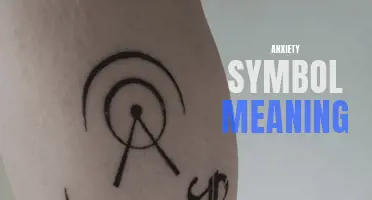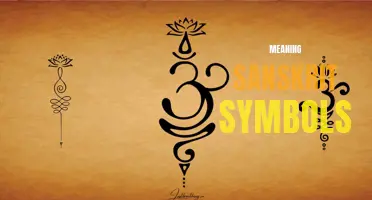
Fingernails, those delicate and often overlooked appendages, hold a significant meaning that goes far beyond their practical use. Symbolizing everything from beauty and status to health and personal expression, fingernails have played a significant role in various cultures and civilizations throughout history. The way we shape and decorate our nails speaks volumes about our identity, beliefs, and even our social status. Join me on a fascinating journey into the symbolic world of fingernails to unravel the hidden meanings behind this seemingly simple feature of our hands.
What You'll Learn
- What is the symbolic meaning behind long fingernails in different cultures?
- How do different nail shapes and colors convey different symbolic meanings?
- What is the significance of painted or decorated fingernails in various traditions and belief systems?
- How do the condition and appearance of someone's fingernails represent their overall health and well-being?
- Are there any superstitions or myths associated with fingernails and their symbolic meanings?

What is the symbolic meaning behind long fingernails in different cultures?
Long fingernails have carried symbolic meanings in different cultures throughout history. These meanings can vary greatly, ranging from status symbols to religious significance. In this article, we will explore some of the symbolic meanings behind long fingernails in different cultures.
In many ancient cultures, long fingernails were associated with wealth and luxury. Having long, manicured nails was a clear indicator that one did not engage in manual labor and had the means to hire others for such work. In ancient Egypt, for example, both men and women of high social status grew out their nails as a statement of their elevated position in society. Similarly, in ancient China, long nails were a sign of wealth and power, and they were often adorned with intricate designs and precious gemstones.
Long fingernails have also held religious significance in certain cultures. In India, for instance, long nails have been associated with spirituality and devotion. Many Hindu deities are depicted with long nails, particularly the goddesses, as a symbol of their divine power. In Jainism, a religion that emerged in ancient India, ascetics are known for growing their nails long as a way to demonstrate their renunciation of worldly possessions and attachments.
Another meaning associated with long fingernails is that of good health and vitality. In traditional Chinese medicine, it is believed that the condition of one's nails can provide insight into their overall health. Long, strong, and well-maintained nails are seen as a sign of robust health and vitality. In this context, having long nails is not only a visual statement but also an indication of one's well-being.
In some cultures, long fingernails have even served as a form of protection. In ancient Japan, warriors would grow out their pinky nails as a weapon known as "tsume." These razor-sharp nails would be used in close combat to slash at an opponent's face or vital areas. This practice, known as "ninja nails," became a symbol of a warrior's skill and fearlessness.
It is important to note that the symbolic meanings behind long fingernails can vary greatly depending on the specific culture and historical context. While long nails were once associated with wealth and power in some cultures, today they are often seen as a personal preference or fashion statement. Ultimately, the significance behind long fingernails lies in the cultural beliefs and values of a particular society.
Decoding Candy Washer Dryer Symbols: What Do They Mean?
You may want to see also

How do different nail shapes and colors convey different symbolic meanings?
Nails have been used as a form of expression for centuries. From ancient Egypt to modern-day society, people have used different nail shapes and colors to convey different symbolic meanings. Whether you prefer long or short nails and bold or neutral colors, your choices can communicate a lot about your personality and individual style.
Firstly, let's discuss how different nail shapes can represent various symbols. The most common nail shape is the oval shape, which is considered classic and versatile. Oval nails are seen as elegant and professional, making them a popular choice for formal occasions or the workplace. On the other hand, square nails are known for their edgier and bolder look. This shape often represents strength and confidence. Almond-shaped nails, with their pointy ends, are associated with femininity and gracefulness. They are a favorite choice among those who want to add a touch of elegance to their style. Lastly, coffin-shaped nails, also known as ballerina nails, are known for their dramatic and glamorous appearance. This shape is often associated with fashion-forward individuals who are not afraid to stand out.
Secondly, let's explore how different nail colors can convey symbolic meanings. Red nails, for example, have long been associated with passion, power, and sensuality. This bold color is often chosen by individuals who want to make a statement and draw attention to themselves. On the other hand, nude or neutral-colored nails are often seen as classy and understated. They are a popular choice for those who prefer a minimalist and polished look. Daring individuals often opt for bright and vibrant nail colors like yellow or neon shades, which can symbolize creativity and a unique sense of style. Pastel colors, such as pale pink or baby blue, often represent femininity and innocence. Lastly, dark colors like black or deep burgundy are often associated with mystery and sophistication.
It is important to note that these symbolic meanings can vary across different cultures and individual interpretations. However, nail shapes and colors still hold significance in the world of beauty and fashion. They can serve as a way to express oneself, make a statement, or simply enhance one's personal style.
In conclusion, different nail shapes and colors can convey different symbolic meanings. Oval nails represent classic elegance, square nails symbolize strength and confidence, almond-shaped nails represent femininity and gracefulness, and coffin-shaped nails represent glamour and drama. Red nails convey passion and power, neutral-colored nails represent understated class, bright colors represent creativity, pastel colors represent femininity and innocence, and dark colors represent mystery and sophistication. Ultimately, the choice of nail shape and color is a personal one, and individuals should choose what resonates with their own style and personality.
Understanding the Symbols on Your Danby Dishwasher
You may want to see also

What is the significance of painted or decorated fingernails in various traditions and belief systems?
In many traditions and belief systems, the significance of painted or decorated fingernails can vary greatly. For some, it is simply a form of self-expression and an opportunity to enhance one's physical appearance. However, in other cultures, there is a deeper meaning behind the practice.
In ancient Egypt, nail decoration was considered a status symbol. The higher the social status of an individual, the more ornate and intricate their nail designs would be. Wealthy Egyptians would often adorn their nails with jewels, gold leaf, and vibrant dyes. It was believed that these decorative nails would also offer protection against evil spirits.
In China, a tradition that dates back over 3000 years, the art of painting nails is deeply rooted in cultural practices. Red was the most common color used, as it was considered auspicious and a symbol of good luck. During the Ming Dynasty, noble ladies would often paint their nails with elaborate designs and patterns, using natural dyes made from flower petals and fruit juices.
In India, henna is commonly used to decorate fingernails and hands during special occasions such as weddings. The intricate designs, known as mehndi, are believed to bring good fortune and ward off evil spirits. The reddish-brown color of the henna is also associated with fertility and prosperity.
In some Native American tribes, nail painting is believed to have spiritual and healing properties. The colors chosen for nail decoration hold specific meanings. For example, red is associated with the life force, blue represents peace and protection, and yellow signifies purity and enlightenment. These beliefs and practices are passed down through generations, symbolizing the connection to their ancestors and their cultural heritage.
In modern times, nail art has become a popular trend across the world. It has evolved into a form of self-expression and a way to showcase individual creativity. People now use various techniques and materials, such as nail polish, gel, acrylics, and even tiny gems or stickers, to create unique designs on their nails.
Overall, the significance of painted or decorated fingernails in various traditions and belief systems is deeply rooted in cultural practices, symbolism, and personal expression. Whether it is used to showcase social status, ward off evil spirits, bring good luck, or simply celebrate individuality, the art of nail decoration continues to hold a special place in many cultures around the world.
Decoding the Nissan Armada Dashboard Symbols and Their Meanings
You may want to see also

How do the condition and appearance of someone's fingernails represent their overall health and well-being?
Our fingernails can serve as a window into our overall health and well-being. They can reveal important information about our nutritional status, the presence of certain diseases or conditions, and even chronic stress levels. By paying attention to changes in the condition and appearance of our fingernails, we can gain valuable insights into our overall health.
One of the most common signs that something may be amiss with our health is changes in the color of our nails. For example, nails that are yellowish or brownish can indicate the presence of a fungal infection. Bluish nails can be a sign of poor circulation or oxygenation. White spots or lines on the nails can signify nutritional deficiencies, particularly of minerals like calcium and zinc. In some cases, the nails may develop a pale or whitish appearance, suggesting anemia or liver disease.
Furthermore, the texture and thickness of our nails can also provide clues about our health. Brittle, weak nails that break easily can be a sign of nutritional deficiencies, particularly of biotin and vitamin C. On the other hand, nails that are thickened or pitted can indicate conditions such as psoriasis or eczema. Changes in the shape or curvature of the nails, such as spoon-shaped nails, can be a sign of iron deficiency anemia.
In addition to color, texture, and thickness, the presence of ridges or grooves on the nails can also indicate an underlying health issue. Horizontal ridges, also known as Beau's lines, can appear after an illness or injury that has disrupted nail growth. Vertical ridges, on the other hand, are a normal part of aging and tend to become more pronounced as we get older. However, deep, wavy ridges can be a sign of underlying health conditions such as diabetes or thyroid problems.
Finally, the cuticles surrounding our nails can also provide valuable information about our health. Dry, cracked cuticles can be a sign of dehydration or a lack of certain vitamins and minerals. Inflammation or swelling of the cuticles may indicate an infection or autoimmune condition.
It's important to note that while changes in the condition and appearance of our fingernails can provide clues about our health, they are not always definitive. A single symptom or change in the nails does not necessarily indicate a serious health issue. However, if you notice persistent or concerning changes in your nails, it is always a good idea to consult with a healthcare professional for further evaluation and guidance.
In conclusion, our fingernails can serve as a valuable tool for assessing our overall health and well-being. Changes in nail color, texture, thickness, shape, and cuticle appearance can provide important clues about nutritional deficiencies, diseases, and chronic stress levels. By paying attention to these changes and seeking medical advice when necessary, we can proactively manage our health and well-being.
Understanding the Meaning of the Lock Symbol on Text Messages
You may want to see also

Are there any superstitions or myths associated with fingernails and their symbolic meanings?
Fingernails have long been associated with various superstitions and myths. Across different cultures and time periods, people have attached symbolic meanings to fingernails, believing that they can reveal information about a person's health, personality, or even their future. While these beliefs may vary, they all contribute to the rich folklore surrounding fingernails.
In many cultures, the shape and appearance of fingernails have been said to hold clues about a person's overall well-being. For instance, in traditional Chinese medicine, pale or brittle nails are believed to indicate poor blood circulation, while yellowish nails may be a sign of digestive issues. Similarly, in Indian culture, longitudinal ridges on the nails are thought to signify weakness in the body.
Superstitions regarding the length of fingernails are also prevalent. In certain Asian cultures, it is considered bad luck for women to have long nails, as they are believed to attract evil spirits. On the other hand, long, well-manicured nails are often associated with a higher social status and femininity in Western societies.
The symbolism associated with nail color is another interesting aspect of nail-related superstitions. In some cultures, each nail color is believed to have a specific meaning. For instance, red nails are associated with passion and vitality, while black nails are said to ward off evil spirits. These beliefs have led to the popularity of nail art and different nail polish colors as a form of self-expression.
Beyond physical characteristics, the act of cutting or trimming fingernails holds significance in many cultural traditions. In South Korea, it is believed that cutting nails at night will bring bad luck and disturb the spirits. Similarly, in various African cultures, cutting nails on certain days of the week or during specific lunar phases is frowned upon, as it is thought to affect one's fortune.
Nail biting, a common habit for many, has also garnered its fair share of superstitions. Some believe that biting nails brings bad luck or invites disease, while others see it as a sign of nervousness or anxiety. This habit has even been associated with an old wives' tale stating that biting nails will lead to a lifetime of financial struggles.
While these superstitions and myths may not have scientific backing, they play an important role in cultural traditions and folklore. They provide a lens into the beliefs and values of different societies, as well as a means of expressing individual identities. Whether one chooses to believe in these symbolic meanings or not, fingernails continue to be an intriguing subject in the realm of superstitions and myths.
Unraveling the Mysteries of Hawaiian Petroglyphs: Symbols and Their Profound Meanings
You may want to see also
Frequently asked questions
If your fingernails are constantly breaking or splitting, it could be a sign of a nutritional deficiency. Brittle nails can indicate a lack of vitamins and minerals, particularly biotin, vitamin E, and iron. It's important to consume a balanced diet that includes foods rich in these nutrients to support healthy nail growth. Additionally, excessive exposure to water, harsh chemicals, or frequent use of nail polish and acrylic nails can also weaken the nails, leading to breakage.
White spots on the fingernails are a common occurrence and are usually harmless. They are often the result of minor injuries to the nail bed, such as banging or bumping the nail. The white spots, known as leukonychia, are actually areas of trapped air or damaged cells and will grow out with time as the nail grows. However, if you notice a sudden increase in the number or size of white spots on your nails, it could be a sign of an underlying medical condition, such as a fungal infection or zinc deficiency, and it's important to consult a healthcare professional.
A yellow tint on the fingernails can have several potential causes. One common cause is staining from nail polish or repeated exposure to certain chemicals or dyes. However, if the yellowing is persistent and not related to external factors, it could be a sign of a fungal infection, particularly if the nail is thickened or brittle. In rare cases, yellow nails can also be a sign of more serious conditions, such as lung or liver disease. If you're concerned about the yellow tint of your nails, it's best to consult a healthcare professional for a proper diagnosis and appropriate treatment.







